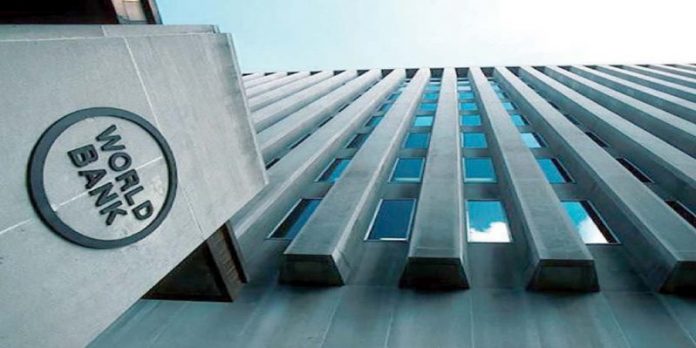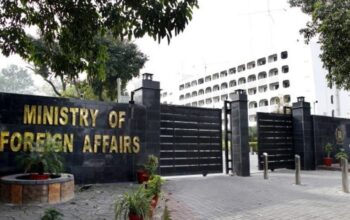Pakistan Development Outlook says implementation of IMF-sponsored reform has been made more challenging by this monsoon’s catastrophic floods.
By Muhammad Ali
ISLAMABAD: As it unveiled a plan to extend development assistance to the tune of $2 billion to help Pakistan rebuild in the wake of this year’s devastating monsoon floods, the World Bank (WB) on Thursday warned that the government will face challenges in implementing the planned fiscal consolidation, given the extensive relief and recovery needs.
The $2 billion loan for flood-affected areas in Pakistan includes repurposing $1 billion from the existing portfolio and requesting its Board to allow another $1 billion through IDA advances.
On the launching of Pakistan Development Outlook here on Thursday, the World Bank’s Country Director Najy Benhassine confirmed that they evaluated each and every project from the existing portfolio and repurposed $1 billion towards flood-affected areas from the existing portfolios.
He said that they also sought permission from the Board to get IDA advances to divert more resources to Pakistan in view of its increased financing requirements in the post-flood scenario. “In totality, the WB is committed to providing $2 billion disbursement for flood-affected areas in Pakistan” he added.
The WB’s Pakistan Development Outlook notes that continued policy tightening has become more challenging on account of the floods. “The government will face challenges in implementing the planned fiscal consolidation, given the extensive relief and recovery needs.
“Additional downside risks include unexpected damages resulting from the still-evolving flooding situation that could further reduce output and worsen economic imbalances; political pressures that undermine the implementation of a coherent and prudent macroeconomic policy mix; unanticipated deterioration of external conditions; and risks associated with large fiscal and external financing needs.
“To manage these uncertainties, the government should adhere to sound economic management, while carefully targeting any new expenditures to the poor and maintaining progress on critical structural reforms, including in the energy sector.”
The Outlook says that supported by accommodative macroeconomic policy, Pakistan’s economy saw robust growth in FY22, at the cost of growing economic imbalances. The government has begun to further tighten policy to constrain aggregate demand.
However, catastrophic flooding is likely to disrupt activity and may lead to delays in the required fiscal consolidation. In the context of high macroeconomic risks and large financing needs, the outlook is sensitive to market perceptions and sentiment.
The government should adhere to sound economic management and carefully communicate a clear strategy for economic recovery, while judiciously targeting any new expenditures and maintaining progress on critical structural reforms, including those in the energy sector.
The WB said: “The economic outlook and prospects for overdue adjustment have been significantly affected by the floods. Agricultural output is expected to decline sharply, with losses to cotton, date, wheat, rice crops, and livestock. Cotton losses are expected to weigh on the domestic textile, wholesale, and transportation service industries. Public relief and recovery efforts are expected to partially offset the loss in activity.
“Real GDP growth is therefore expected to slow to 2.0 percent in FY23, but recover to 3.2 percent by FY24, supported by a rebound in agricultural production, reconstruction efforts, and projected lower global inflationary pressures.
“Due to higher domestic energy prices, flood disruptions, and the weaker Rupee, inflation is projected to rise to 23.0 percent in FY23 but moderate to 9.5 percent in FY24 with declining international energy prices and resolution of flood-related supply constraints.
“Despite flood-associated effects, the CAD is expected to narrow slightly to 4.3 percent of GDP in FY23, partly due to stronger remittance inflows, and is projected to shrink further in FY24 as exports recover from flood impacts.
“In line with fiscal consolidation efforts and lower subsidy expenditures, the primary deficit (excluding grants) is forecast to narrow from 3.1 percent of GDP in FY22 to 3.0 percent in FY23, despite negative impacts to revenue bases and increased expenditure needs due to the floods.
“Similarly, the fiscal deficit is projected to contract by one percentage point to 6.9 percent of GDP in FY23 and is expected to gradually narrow over the medium term as revenue mobilization measures take hold, particularly GST harmonization and personal income tax reform.
“With rapid nominal GDP growth, public debt as a share of GDP is projected to decline gradually over the forecast period, despite continued primary deficits. The macroeconomic outlook is predicated on the IMF-EFF program remaining on track.”
The World Bank believes that the devastating floods will have adverse effects on poverty reduction.
“The floods will impact households through at least four channels that include: (i) reduced income due to lost harvests and livestock, or loss of livelihood; (ii) loss of assets, such as homes, livestock, productive equipment, and household durables; (iii) shortages of food due to lost food stocks, poor harvests and rising food prices; and (iv) loss of human capital, due to disease, food shortages and prolonged school closures.
“Preliminary estimates suggest that as a direct consequence of the floods, the national poverty rate can increase by 2.5 to 4.0 percentage points, pushing between 5.8 and 9.0 million people into poverty.
“Reversing these negative socio-economic effects is likely to take considerable time, and some losses, such as those to human capital and land productivity, can lead to more sustained declines in welfare and will warrant specific policy attention.”
Given the recent spikes in inflation, this Outlook examines the impact of inflation on household welfare and reviews policy options to cushion the effects of rising prices on the poor. By accounting for differences in consumption patterns and in price trends across various goods and services, it identifies the differential impact of inflation across income groups.
The analysis shows that the recent bout of inflation has had disproportionately adverse impacts on the poor. More specifically, the analysis shows that the poorest households, on average, experienced inflation rates that were one percentage point higher than the wealthiest households.
“Apart from a sound macroeconomic policy mix, sectoral policies with sustainable fiscal costs that largely benefit poor households, like reducing import duties on sensitive food products, could help to reduce inflationary pressures”, says the World Bank.
“These policies could be complemented with well-targeted temporary expansions of social protection programs to mitigate the impact of higher inflation on poor households. Over the medium term, enhancing economy-wide productivity growth through reforms in the agriculture and energy sectors could further ease inflationary pressures.”
Copyright © 2021 Independent Pakistan | All rights reserved




